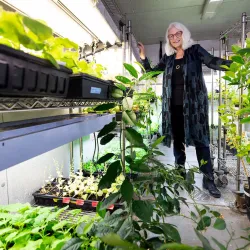Developing Cells Reach Out for Instructions
UMD-led research suggests that cells in developing fruit fly air sacs extend armlike projections to physically grab signaling proteins
All animals—from the tiniest fruit flies to the largest whales—spend their earliest moments as a clump of identical, unspecialized cells. These cells change to form tissues and organs when they receive instructions from signaling proteins called morphogens. For example, a morphogen called Branchless helps direct the development of lunglike organs known as air sacs in fruit flies. A closely related morphogen also directs the development of lungs in humans.
New research from the University of Maryland describes how morphogens move in a developing fruit fly embryo to send their messages. Previous research suggested that morphogens diffuse from a source cell, passively making their way to developing cells. But the UMD group’s work suggests that developing cells actively reach out using tiny armlike projections, grabbing morphogen molecules and bringing them directly to the cell.
The new research, led by Sougata Roy, an assistant professor of cell biology and molecular genetics at UMD, was published in the journal eLife on October 17, 2018.
“Uncovering the fundamental mechanisms that cells employ to communicate will have significant implications for our understanding of both normal development and diseases. These findings could eventually be extended to humans as well,” Roy said. “Understanding the fundamental principles of cell communication can also help ensure future success in tissue engineering.”
Researchers have long known that the effect of a morphogen depends on its concentration. Roy and his team found that air sac cells exposed to high concentrations of Branchless form the tip of a developing air sac, while cells exposed to low concentrations of Branchless form the base of the organ, where it connects to the rest of the fly’s respiratory system. In between these two extremes, the concentration of Branchless varies along a continuous gradient.
Developmental biologists have puzzled over how such gradients of morphogen proteins form in developing animal tissues. A longstanding assumption is that signaling molecules passively diffuse from a source cell, resulting in higher concentrations near the source cell that decrease and become more sparse with distance. But Roy and his colleagues’ findings suggest that developing cells take a much more active role in determining their own fate.
Using fruit flies genetically engineered to produce fluorescently tagged Branchless proteins, Roy and his team directly imaged the activity of Branchless in developing fruit fly air sacs. They observed several tiny, armlike projections sprouting from the air sac cells, reaching toward a nearby source of Branchless proteins.
These arms, called cytonemes, grab hold of Branchless proteins and physically bring them from the source cells directly to the air sac cells. Air sac cells at the tip of the air sac sent out the highest number of cytonemes, while those closer to the base produced the fewest cytonemes.
The researchers also found that Branchless activates different genes in different locations along the developing air sac, instructing each cell to extend a specific number of cytonemes. With these instructions, Branchless is able to create and maintain its own gradient, which determines the air sac’s final shape.
“Our findings introduce a completely new paradigm of signal gradient formation and tissue morphogenesis,” Roy said. “Future research will need to address how cytonemes form and how they find their way to the source cells that produce morphogens.Learning more about how cells exchange information could help researchers understand how these systems fail and lead to disorders.”
###
In addition to Roy, UMD-affiliated co-authors of the research paper include Cell Biology and Molecular Genetics postdoctoral researcher Lijuan Du, graduate student Alex Sohr and research assitant Ge Yan.
The research paper, “Feedback regulation of cytoneme-mediated transport shapes a tissue-specific FGF morphogen gradient,” Lijuan Du, Alex Sohr, Ge Yan and Sougata Roy, was published in the journal eLife on October 17, 2018.
This work was supported by the National Institutes of Health (Award Nos. R00HL114867 and R35GM124878). The content of this article does not necessarily reflect the views of this organization.







